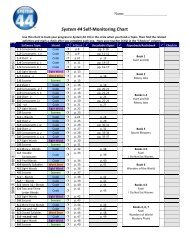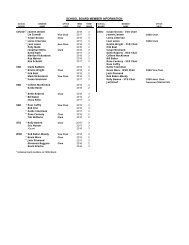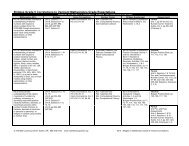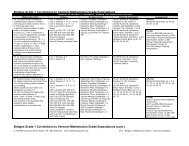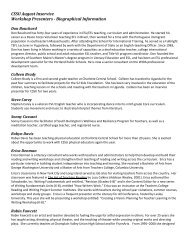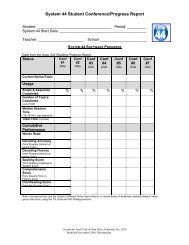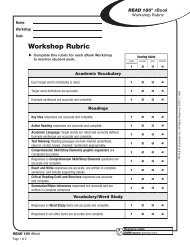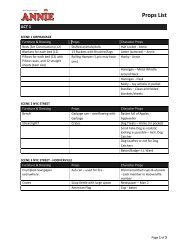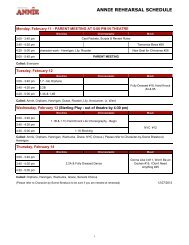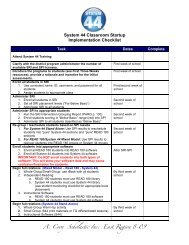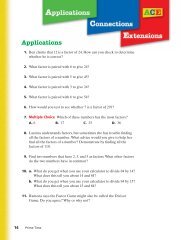Domain #1 – Planning and Preparation Danielson's Framework for ...
Domain #1 – Planning and Preparation Danielson's Framework for ...
Domain #1 – Planning and Preparation Danielson's Framework for ...
Create successful ePaper yourself
Turn your PDF publications into a flip-book with our unique Google optimized e-Paper software.
<strong>Domain</strong> <strong>#1</strong> <strong>–</strong> <strong>Planning</strong> <strong>and</strong> <strong>Preparation</strong> Danielson’s <strong>Framework</strong> <strong>for</strong> Teaching<br />
Component 1a: Demonstrating Knowledge of Content <strong>and</strong> Pedagogy<br />
ELEMENT<br />
LEVEL OF PERFORMANCE<br />
UNSATISFACTORY BASIC PROFICIENT DISTINGUISHED<br />
Knowledge of Content<br />
Teacher makes content errors or<br />
does not correct content errors<br />
students make.<br />
Teacher displays basic content<br />
knowledge but cannot articulate<br />
connections with other parts of<br />
the discipline or with other<br />
disciplines.<br />
Teacher displays solid content<br />
knowledge <strong>and</strong> makes<br />
connections between the content<br />
<strong>and</strong> other parts of the discipline<br />
<strong>and</strong> other disciplines.<br />
Teacher displays extensive<br />
content knowledge, with evidence<br />
of continuing pursuit of such<br />
knowledge.<br />
Knowledge of<br />
Prerequisite<br />
Relationships<br />
Teacher displays little<br />
underst<strong>and</strong>ing of prerequisite<br />
knowledge important <strong>for</strong> student<br />
learning of the content.<br />
Teacher indicates some awareness<br />
of prerequisite learning, although<br />
such knowledge may be<br />
incomplete or inaccurate.<br />
Teacher’s plans <strong>and</strong> practices<br />
reflect underst<strong>and</strong>ing of<br />
prerequisite relationships among<br />
topics <strong>and</strong> concepts.<br />
Teacher actively builds on<br />
knowledge of prerequisite<br />
relationships when describing<br />
instruction or seeking causes <strong>for</strong><br />
student misunderst<strong>and</strong>ing.<br />
Knowledge of Content-<br />
Related Pedagogy<br />
Teacher displays little<br />
underst<strong>and</strong>ing of pedagogical<br />
issues involved in student<br />
learning of the content.<br />
Teacher displays basic<br />
pedagogical knowledge but does<br />
not anticipate student<br />
misconceptions.<br />
Pedagogical practices reflect<br />
current research on best<br />
pedagogical practice within the<br />
discipline but without anticipating<br />
student misconceptions.<br />
Teacher displays continuing<br />
search <strong>for</strong> best practice <strong>and</strong><br />
anticipates student<br />
misconceptions.
<strong>Domain</strong> <strong>#1</strong> <strong>–</strong> <strong>Planning</strong> <strong>and</strong> <strong>Preparation</strong> Danielson’s <strong>Framework</strong> <strong>for</strong> Teaching<br />
ELEMENT<br />
Knowledge of<br />
Characteristics of Age<br />
Group<br />
Component 1b: Demonstrating Knowledge of Students<br />
LEVEL OF PERFORMANCE<br />
UNSATISFACTORY BASIC PROFICIENT DISTINGUISHED<br />
Teacher displays minimal<br />
knowledge of developmental<br />
characteristics of age group.<br />
Teacher displays generally<br />
accurate knowledge of<br />
developmental characteristics of<br />
age group.<br />
Teacher displays thorough<br />
underst<strong>and</strong>ing of typical<br />
developmental characteristics of<br />
age group as well as exceptions to<br />
general patterns.<br />
Teacher displays knowledge of<br />
typical developmental<br />
characteristics of age group,<br />
exceptions to the patterns, <strong>and</strong> the<br />
extent to which each student<br />
follows patterns.<br />
Knowledge of Students’<br />
Varied Approaches to<br />
Learning<br />
Teacher is unfamiliar with the<br />
different approaches to learning<br />
that students exhibit, such as<br />
learning styles, modalities, <strong>and</strong><br />
different “intelligences.”<br />
Teacher displays general<br />
underst<strong>and</strong>ing of the different<br />
approaches to learning that<br />
students exhibit.<br />
Teacher displays solid<br />
underst<strong>and</strong>ing of the different<br />
approaches to learning the<br />
different students exhibit.<br />
Teacher uses, where appropriate,<br />
knowledge of students’ varied<br />
approaches to learning in<br />
instructional planning.<br />
Knowledge of Students’<br />
Skills <strong>and</strong> Knowledge<br />
Teacher displays little knowledge<br />
of students’ skills <strong>and</strong> knowledge<br />
<strong>and</strong> does not indicate that such<br />
knowledge is valuable.<br />
Teacher recognizes the value of<br />
underst<strong>and</strong>ing students’ skills <strong>and</strong><br />
knowledge but displays this<br />
knowledge <strong>for</strong> the class only as a<br />
whole.<br />
Teacher displays knowledge of<br />
students’ skills <strong>and</strong> knowledge <strong>for</strong><br />
groups of students <strong>and</strong> recognizes<br />
the value of this knowledge.<br />
Teacher displays knowledge of<br />
students’ skills <strong>and</strong> knowledge <strong>for</strong><br />
each student, including those with<br />
special needs.<br />
Knowledge of students’<br />
interests <strong>and</strong> cultural<br />
heritage<br />
Teacher displays little knowledge<br />
of students’ interests or cultural<br />
heritage <strong>and</strong> does not indicate that<br />
such knowledge is valuable.<br />
Teacher recognizes the value of<br />
underst<strong>and</strong>ing students’ interests<br />
or cultural heritage but displays<br />
this knowledge <strong>for</strong> the class only<br />
as a whole.<br />
Teacher displays knowledge of<br />
the interests or cultural heritage of<br />
groups of students <strong>and</strong> recognizes<br />
the value of this knowledge.<br />
Teacher displays knowledge of<br />
the interests or cultural heritage of<br />
each student.
<strong>Domain</strong> <strong>#1</strong> <strong>–</strong> <strong>Planning</strong> <strong>and</strong> <strong>Preparation</strong> Danielson’s <strong>Framework</strong> <strong>for</strong> Teaching<br />
ELEMENT<br />
Value<br />
Component 1c: Selecting Instructional Goals<br />
LEVEL OF PERFORMANCE<br />
UNSATISFACTORY BASIC PROFICIENT DISTINGUISHED<br />
Goals are not valuable <strong>and</strong><br />
represent low expectations or no<br />
conceptual underst<strong>and</strong>ing <strong>for</strong><br />
students. Goals do not reflect<br />
important learning.<br />
Goals are moderately valuable in<br />
either their expectations or<br />
conceptual underst<strong>and</strong>ing <strong>for</strong><br />
students <strong>and</strong> in importance of<br />
learning.<br />
Goals are valuable in their level<br />
of expectations, conceptual<br />
underst<strong>and</strong>ing, <strong>and</strong> importance of<br />
learning.<br />
Not only are the goals valuable,<br />
but teachers can also clearly<br />
articulate how goals establish<br />
high expectations <strong>and</strong> relate to<br />
curriculum frameworks <strong>and</strong><br />
st<strong>and</strong>ards.<br />
Clarity<br />
Goals are either not clear or are<br />
stated as student activities. Goals<br />
do not permit viable methods of<br />
assessment.<br />
Goals are only moderately clear<br />
or include a combination of goals<br />
<strong>and</strong> activities. Some goals do not<br />
permit viable methods of<br />
assessment.<br />
Most of the goals are clear but<br />
may include a few activities. Most<br />
permit viable methods of<br />
assessment.<br />
All the goals are clear, written in<br />
the <strong>for</strong>m of student learning, <strong>and</strong><br />
permit viable methods of<br />
assessment.<br />
Suitability <strong>for</strong> Diverse<br />
Students<br />
Goals are not suitable <strong>for</strong> the<br />
class.<br />
Most of the goals are suitable <strong>for</strong><br />
most students in the class.<br />
All the goals are suitable <strong>for</strong> most<br />
students in the class.<br />
Goals take into account the<br />
varying learning needs of<br />
individual students or groups.<br />
Balance<br />
Goals reflect only one type of<br />
learning <strong>and</strong> one discipline or<br />
str<strong>and</strong>.<br />
Goals reflect several types of<br />
learning but no ef<strong>for</strong>t at<br />
coordination or integration.<br />
Goals reflect several different<br />
types of learning <strong>and</strong><br />
opportunities <strong>for</strong> integration.<br />
Goals reflect student initiative in<br />
establishing important learning.<br />
ELEMENT<br />
Resources <strong>for</strong> Teaching<br />
Component 1d: Demonstrating Knowledge of Resources<br />
LEVEL OF PERFORMANCE<br />
UNSATISFACTORY BASIC PROFICIENT DISTINGUISHED<br />
Teacher is unaware of resources<br />
available through the school or<br />
district.<br />
Teacher displays limited<br />
awareness of resources available<br />
through the school or district.<br />
Teacher is fully aware of all<br />
resources available through the<br />
school or district.<br />
In addition to being aware of<br />
school <strong>and</strong> district resources,<br />
teacher actively seeks other<br />
materials to enhance instruction,<br />
<strong>for</strong> example, from professional<br />
organizations or through the<br />
community.<br />
Resources <strong>for</strong> Students<br />
Teacher is unaware of resources<br />
available to assist students who<br />
need them.<br />
Teacher displays limited<br />
awareness of resources available<br />
through the school or district.<br />
Teacher is fully aware of all<br />
resources available through the<br />
school or district <strong>and</strong> knows how<br />
to gain access <strong>for</strong> students.<br />
In addition to being aware of<br />
school <strong>and</strong> district resources,<br />
teacher is aware of additional<br />
resources available through the<br />
community.
<strong>Domain</strong> <strong>#1</strong> <strong>–</strong> <strong>Planning</strong> <strong>and</strong> <strong>Preparation</strong> Danielson’s <strong>Framework</strong> <strong>for</strong> Teaching<br />
ELEMENT<br />
Learning Activities<br />
Component 1e: Designing Coherent Instruction<br />
LEVEL OF PERFORMANCE<br />
UNSATISFACTORY BASIC PROFICIENT DISTINGUISHED<br />
Learning activities are not<br />
suitable to students or<br />
instructional goals. They do not<br />
follow an organized progression<br />
<strong>and</strong> do not reflect recent<br />
professional research.<br />
Only some of the learning<br />
activities are suitable to students<br />
or instructional goals. Progression<br />
of activities in the unit is uneven,<br />
<strong>and</strong> only some activities reflect<br />
recent professional research.<br />
Most of the learning activities are<br />
suitable to students <strong>and</strong><br />
instructional goals. Progression of<br />
activities in the unit is fairly even,<br />
<strong>and</strong> most activities reflect recent<br />
professional research.<br />
Learning activities are highly<br />
relevant to students <strong>and</strong><br />
instructional goals. They progress<br />
coherently, producing a unified<br />
whole <strong>and</strong> reflecting recent<br />
professional research.<br />
Instructional Materials<br />
<strong>and</strong> Resources<br />
Materials <strong>and</strong> resources do not<br />
support the instructional goals or<br />
engage students in meaningful<br />
learning.<br />
Some of the materials <strong>and</strong><br />
resources support the instructional<br />
goals, <strong>and</strong> some engage students<br />
in meaningful learning.<br />
All materials <strong>and</strong> resources<br />
support the instructional goals,<br />
<strong>and</strong> engage students in<br />
meaningful learning.<br />
All materials <strong>and</strong> resources<br />
support the instructional goals,<br />
<strong>and</strong> most engage students in<br />
meaningful learning. There is<br />
evidence of student participation<br />
in selecting or adapting materials.<br />
Instructional Groups<br />
Instructional groups do not<br />
support the instructional goals <strong>and</strong><br />
offer no variety.<br />
Instructional groups are<br />
inconsistent in suitability to the<br />
instructional goals <strong>and</strong> offer<br />
minimal variety.<br />
Instructional groups are varied, as<br />
appropriate to the different<br />
instructional goals.<br />
Instructional groups are varied, as<br />
appropriate to the different<br />
instructional goals. There is<br />
evidence of student choice in<br />
selecting different patterns of<br />
instructional groups.<br />
Lesson <strong>and</strong> Unit<br />
Structure<br />
The lesson or unit has no clearly<br />
defined structure, or the structure<br />
is chaotic. Time allocations are<br />
unrealistic.<br />
The lesson or unit has a<br />
recognizable structure, although<br />
the structure is not uni<strong>for</strong>mly<br />
maintained throughout. Most time<br />
allocations are reasonable.<br />
The lesson or unit has a clearly<br />
defined structure that activities<br />
are organized around. Time<br />
allocations are reasonable.<br />
The lesson’s or unit’s structure is<br />
clear <strong>and</strong> allows <strong>for</strong> different<br />
pathways according to student<br />
needs.
<strong>Domain</strong> <strong>#1</strong> <strong>–</strong> <strong>Planning</strong> <strong>and</strong> <strong>Preparation</strong> Danielson’s <strong>Framework</strong> <strong>for</strong> Teaching<br />
ELEMENT<br />
Congruence with<br />
Instructional Goals<br />
Component 1f: Assessing Student Learning<br />
LEVEL OF PERFORMANCE<br />
UNSATISFACTORY BASIC PROFICIENT DISTINGUISHED<br />
Content <strong>and</strong> methods of<br />
assessment lack congruence with<br />
instructional goals.<br />
Some of the instructional goals<br />
are assessed through the proposed<br />
approach, but many are not.<br />
All the instructional goals are<br />
nominally assessed through the<br />
proposed plan, but the approach is<br />
more suitable to some goals than<br />
to others.<br />
The proposed approach to<br />
assessment is completely<br />
congruent with the instructional<br />
goals, both in content <strong>and</strong><br />
process.<br />
Criteria <strong>and</strong> St<strong>and</strong>ards<br />
The proposed approach contains<br />
no clear criteria or st<strong>and</strong>ards.<br />
Assessment criteria <strong>and</strong> st<strong>and</strong>ards<br />
have been developed, but they are<br />
either not clear or have not been<br />
clearly communicated to students.<br />
Assessment criteria <strong>and</strong> st<strong>and</strong>ards<br />
are clear <strong>and</strong> have been clearly<br />
communicated to students.<br />
Assessment criteria <strong>and</strong> st<strong>and</strong>ards<br />
are clear <strong>and</strong> have been clearly<br />
communicated to students. There<br />
is evidence that students<br />
contributed to the development of<br />
the criteria <strong>and</strong> st<strong>and</strong>ards.<br />
Use <strong>for</strong> <strong>Planning</strong><br />
The assessment results affect<br />
planning <strong>for</strong> these students only<br />
minimally.<br />
Teacher uses assessment results to<br />
plan <strong>for</strong> the class as a whole.<br />
Teacher uses assessment results to<br />
plan <strong>for</strong> individuals <strong>and</strong> groups of<br />
students.<br />
Students are aware of how they<br />
are meeting the established<br />
st<strong>and</strong>ards <strong>and</strong> participate in<br />
planning the next steps.



